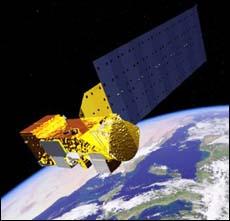|
In addition, the MODIS instrument's ability to detect very
long wavelength radiation enables it to measure the temperature of
surface waters, since the ocean's temperature is revealed by the
infrared radiation it emits. Remember, upwelling is revealed by
cooler waters rising to the surface, and thus by monitoring sea
surface temperature and chlorophyll abundance we can detect both the
physical process of upwelling and the biological response that
results from it! MODIS instruments are mounted on two satellites
(Terra and Aqua) as part of the Earth Observing System (EOS). The
orbits of these satellites have been synchronously paired to allow
for full coverage of the earth's surface every 1-2 days.
|

Artist's rendition of the Aqua satellite, which, along with
its partner Terra, carries a MODIS sensor as part of the Earth
Observatory System.
Image courtesy NASA.
|